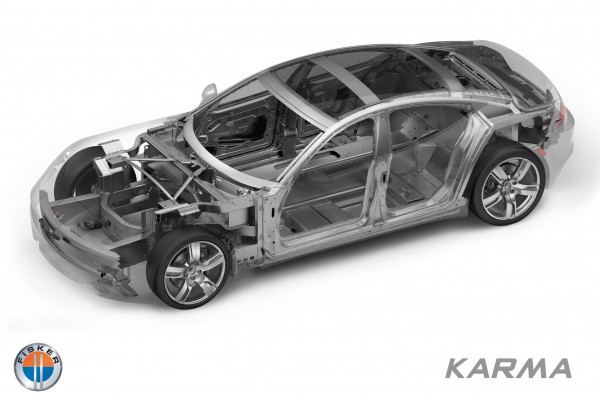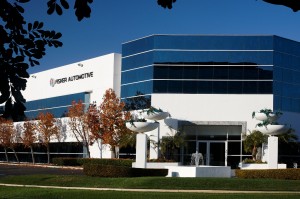
The advanced aluminum space frame underpinning the Fisker Karma incorporates new levels of rigidity and strength that will give the world’s first premium plug-in hybrid electric vehicle world-class ride and handling characteristics. It will debut at the Geneva Motor Show March 2-14, 2010. Fisker Automotive’s talented and experienced engineering team designed the Karma’s space frame around the car’s unique Q-DRIVE® series-hybrid powertrain, filing for multiple patents in the process. Q-DRIVE® consists of a 2.0-liter turbocharged ECOTEC® engine/generator set, a lithium-ion battery pack from A123 Systems, and a rear-mounted 403hp traction motor assembly.
Though it forms the foundation of a large sedan the Karma space frame’s rigidity is exceptional even when compared to today’s sports cars. By utilizing 5,000- and 6,000-series aluminum alloys and a unique extrusion-intensive architecture, the Fisker engineering team achieved the best balance between weight and size. “Our top priorities when we designed the Karma’s aluminum space frame were that it have extremely high torsional rigidity and could be easily modified to accept Karma model variants,” explained Henrik Fisker, CEO, Fisker Automotive. “We benchmarked some of the world’s best cars to create an all-new space frame that will deliver an exhilarating experience behind the wheel. A super-structural tunnel running down the car’s centerline acts as the Karma’s backbone. It not only houses the battery pack but acts as a torque tube connecting front and rear sections. For optimal strength the Karma’s space frame is joined with 79 meters of precision CMT MIG welds and 1,058 buyambienmed.com self-piercing rivets. Each technique is used independently only where necessary to ensure top quality and durability. The result is an industry-leading space frame that provides a solid foundation for the Karma. Few cars match its statistics: Static torsional rigidity – the amount the space frame resists twisting forces when entering a ramp at an angle, for example –measures more than 33,000 Newton-meters per degree (Nm/deg). Static bending rigidity – the amount the space frame resists flexing forces as the car enters a ramp straight on, for example – measures more than 23,000 N/mm. Dynamic stiffness – the space frame’s resistance to resonant vibrations like those felt when driving over a sharp bump or rough road surfaces—is also world class.
Priority: Safety
Thanks to intelligent engineering solutions the Karma’s space frame also provides the utmost in occupant safety and exceeds global crash protection standards. Front impact protection starts with a patent-pending, multi-cell tempered aluminum crush box that displaces high-impact energy away from passengers. Its unique design allows it to be easily replaced, reducing repair costs that could lower insurance premiums. Dual Phase 600-Series steel reinforced components in the doors and Bpillars provide substantial side impact protection. And the lithium-ion battery’s location in the center of the car puts it farthest from impact areas. Valmet Automotive will assemble the space frames at its state-of-the-art facility in Uusikaupunki, Finland.
[Source: Fisker Automotive; Image: TheMotorReport]
